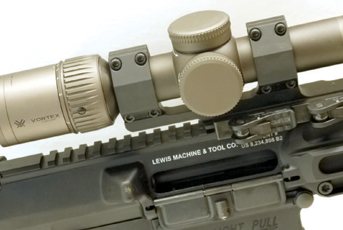Vortex Razor
- By Pete Moore
-
0
 Comments
Comments
- Last updated: 16/12/2016

You have probably noticed that I have been using a lot of Vortex optics over the last six months in both stand alone tests and as my optic of choice on certain rifles. Last issue (October 2013) I had the pleasure of testing the civilian version of the British L129A1 Sharpshooter, in service it mounts an x6 ACOG. I rang importers Riflecraft Ltd and asked them for something suitable, fully expecting a hi-mag variable I was pleasent surprised by the Razor HD Gen II 1 – 6 x24 Unit.
I like what I term as compacts or dangerous game scopes with a variable magnification of around 1 – 6 and a small to medium objective 24 – 42mm. Light and handy they are great for close up as well as mid/longer range use. I currently have four – Zeiss, Kahles, Leupold and S&B and after this test am seriously thinking of adding the Razor too.
TOP END
Vortex offers a number of levels of optic with the Razor being the top end, in past issue Chris Parkin tested their all singing, dancing, hi-mag/spec tactical, which is distinctive by its bronze body colour. The 1-6x24 was conceived as a short to mid-range (20 – 600 yard) optic primarily for AR15s. The JM-1 reticule was collaboration with top US shooter Jerry Miculek and Vortex and gives a versatile yet simple pattern equally well suited for 223
Rem and 308 Win rifles. Add into the mix the near bomb-proof build and compact layout of the 1-6x24 and as I discovered last month you have quite some scope that punches well above its weight.
Though short at 10.1” the Razor weighs a hefty 25.2 oz. The build goes for a 30mm body tube with a pull-out and turn rheostat on the left of the saddle and two of the largest, flattest turrets I have seen! In proportion they look like dustbin lids, but are easy to use and see. In keeping with the usage they offer ½-MOA clicks, with 50-clicks per turn and three full rotations. On elevation the turret is marked in 2-MOA divisions, sub-divided into four x .5 MOA. Windage is the same but divided 25-MOA left and right, with individual 2-MOA divisions marked with a number and also the letter R or L to denote direction so you can lay in left or right corrections easily. Unlike their Viper 1-4x24 compact the turrets on the Razor are capped.
The rheostat has switch-off points between the 11 brightness settings, so you can select a level of illumination you want then just click back one to turn it off and then forward to turn it on, so no having to wind up through the numbers. Sensibly only the intersection of the central cross is lit so does not blow the sight picture even at higher levels.
JM-1 STANDARD BULLET DROP
The JM-1 reticule is deceptively simple but caters for both 223 and 308 ballistics. Set in the 2nd focal plane (SFP) it consists of a #4-type cross with long/slim, 6 o’clock inner stadia with four hash marks based around a 200 yard zero setting! Like any BDC (bullet drop compensating) reticule the JM-1 is a compromise. But one that with a bit of work you can work to your advantage. Vortex have a ballistic programme that you can use but the basics of the system are as follows; let’s start with 223 Rem.
The JM-1 will handle standard bullet drops for both civilian (223 Rem) and military-type (5.56x45mm) loads from 55 to 77 grain boat tail bullet-types and speeds from 3000 to 2700 fps. Rule of thumb drops for the four hash marks are #1 (300 yards) 7.5”, #2 400 yards 23.5”, #3 500 yards 50” and #4 600 yards 92”. Equally with 308 Win/7.62x51mm though with this calibre they quote a 168 grain Match types at 2650 fps and 175 grain at 2600 fps like the Hornady A-MAX or Sierra BT/HP Match King etc, but it will doubtless accommodate the standard NATO 147 grain ball/FMJ load too: #1 285 yards 7.2”, #2 385 yards 22”, #3 485 yards 47.4” and #4 600 yards 92”. Being SFP all the setting must be done at the maximum magnification of x6!
SHOOT THE DISTANCES
Vortex supply all relevant reticule subtension data and all you have to do is apply your load to the JM-1 and see what suits best, or use their ballistic resource. However, you do need to get out on the ground and shoot the distances as barrel length and cartridge/calibre specifications will differ in the real world. I say this for any BDC-type systems as there’s no guarantee that supplied data will match your real time performance! However, it’s a simple and easily workable system and one that offers a lot of plus points; it’s just down to you how you make use of them.
Vortex’s build quality is second to none with the Razor series being a great example! The APO objective uses index-matched lenses to correct colour across the entire visual spectrum. The HD lens elements with its premium (High Density) extra-low dispersion glass delivers good resolution and colour fidelity that result in true hi-definition images. Combine this with XR fully multi-coated lenses that also increase light transmission so offering maximum brightness. As I said in the Sharpshooter gun test from last month though a x6 the Razor felt like a x8 on target.
Not only did I find the 1-6x24 a good looking and practical design, but really fell in love with its ability to perform for all needs.
